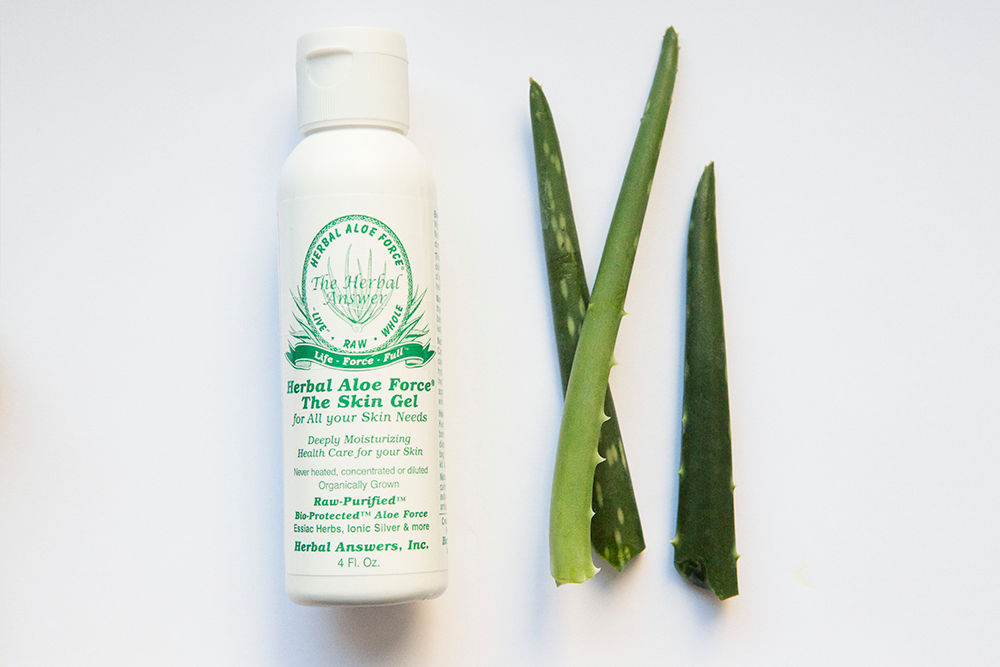You’re on vacation with your family in Florida. You develop the worst sunburn of your life. Your mom runs out to the local surf shop that has, curiously, no boards or wax but an infinite amount of nameplate key chains, and she buys a 2-liter-Coke-sized tub of alien-green aloe vera gel, with those blubbery, wiggly ebbs and flows in the bottle, all air pockets and jiggly goo. It’s got a bright-blue pump, a cartoonish lizard wearing sunglasses, and more than one shade of neon on the bottle. It's so unappealing you throw it away before packing up and leaving paradise.
This is your primary experience with aloe. That, and maybe cutting one of those flowering succulents because those juicy leaves are just asking for it. But aloe has unsuspected depth—and it's worth looking past that alien-green tub of goo. In its natural state, it's a magical, go-everywhere, do-everything-type salve that helps pretty much anything you put it on. If you have trouble deciding whether you should buy a product, check to see if it has aloe in it. If so, that’s a pretty good reason to buy it immediately. Aloe has been historically used as an all-purpose first-aid remedy, so don’t think that’s limited to burned backs—there’s shampoos, scalp treatments, deodorants, toothpastes, and drinks galore.
For a professional take on the substance, I spoke with my long-time, down-home, incredibly kind (and unbelievably skilled) certified physician assistant, Loree A. Easley at Mid-South Dermatology and Skin Cancer Center, about aloe. Of course, working in beauty in the capacity I do, I sometimes expect medical professionals to talk like a WikiHow on natural ingredients—“Put some in your coffee! Try this as a foot rub!”—when of course, they’re medical professionals, not enthusiasts. They're much given to the scientific method and cautionary endorsements, which is appropriate (whereas you can search my byline for gushing exuberance all starting with “I just feel like...”). The role of the doctor is different. Easley calmed my aloe fervor a little with a preliminary condition.
“So with aloe, it is not a common sole ingredient that I recommend, but I feel it is helpful with minor skin irritations and sunburns. Aloe, like many other herbal products can be helpful but is not a medication that is regulated by the FDA,” she said. “ I would use aloe for minor skin irritations, sunburns, [as] a moisturizer for dry skin, and for radiation dermatitis.” May I also advise against Googling ‘radiation dermatitis’ while eating lunch and/or in a good mood.
With the official take in, allow me to extrapolate on my own (subjective) experience. My preferred aloe source is Herbal Answers' Herbal Aloe Force The Skin Gel. Described to me at my local health food store as a true all-purpose—you can put it anywhere and even ingest it—Aloe Force is raw, unheated aloe puree (rinds and all) with an herbal infusion of cat’s claw, slippery elm, and the very calming chamomile. If you think, as I used to, that your underlying skin tone is blotchy or ruddy, try a thin film of aloe vera—the redness that I thought was a natural part of my skin tone was calmed right out. It’s also perfect to use as a serum/ base/ precursor to all my other creams since it establishes a protective, slightly gelatinous barrier between your skin and the world, taking the sting out of any heavier cream you put on top. Obviously, it’s best to stay away from creams that sting and burn altogether but windburn, sunburn, retinols, and even over-exfoliation can sometimes make creams that would otherwise glide and nourish feel less than gentle. Lay down a thin film of aloe, and you’ve got a protective barrier and a hydrating sieve that will let in nutrients over time. It’s incredibly calming, seems to take out redness, and is super gentle with acne. It’s great to lay down before an acne treatment too, from salicylic acid to Tazorac.
From a little online research, it would appear that more than a sliver of consumers opt to ingest a good deal of Aloe Force. If you’re into more topical uses, it’s great as a gentle makeup remover—since it’s food-grade, getting a little in your eyes won't hurt you. I use it as an all-around vehicle for moisturizing and soothing—put a little on lips before a lip scrub or some on your cuticles before your nightly hand cream. Aloe is also thought to stimulate hair growth, so when I put it on as a clear mascara and a brow gel, I feel good hoping that there’s a little extra magic happening there.
So whatever your need is, try aloe for it. My own personal challenge is to switch out Vaseline, or even my beloved Homeoplasmine, with aloe for a week. Just see what happens. You might just be converted over to the succulent side.
—Trace Barnhill
Photographed by Tom Newton.

